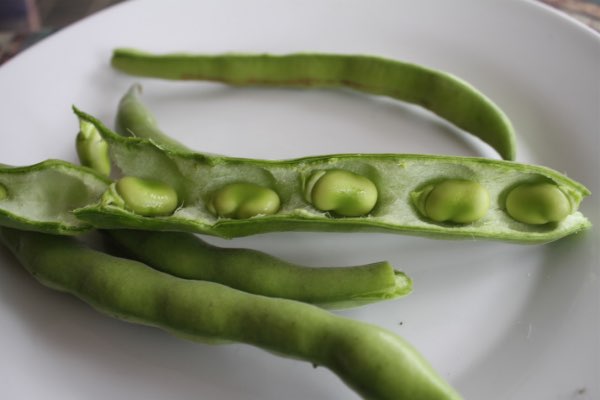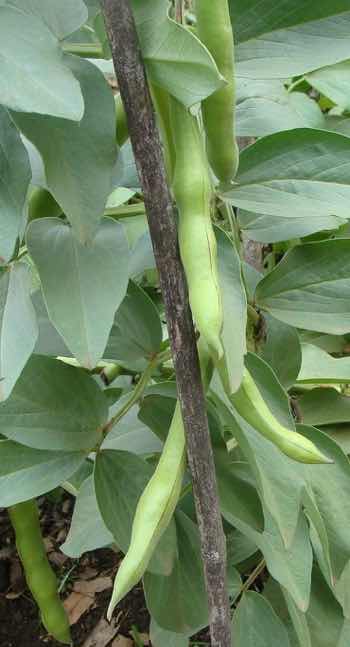- Bernard Preston homepage
- Our green garden
- Broad Beans
Broad beans
Broad beans was first published in the local newspaper in a column about our green home.
Sugar beans are a major source of protein for many South Africans, especially the poor and vegetarians; however there are problems. The price has increased sharply, in part because of the drought.
The price
of seed of new varieties has shot up since major agricultural companies have
become involved with new hybrids; they are reportedly more resistant to
mildew and other pests that have caused poor yields.
Retail prices increased by over 70 percent in the first six months of 2019.
This page was updated on 8th October, 2024.

Beans in general have large amounts of soluble fibre making them the perfect food for those who suffer from raised blood glucose; that is a huge problem in South Africa.
By forming a gel in the gut they slow down the rapid absorption of the starch in refined carbohydrates like white rice that we as a nation have come to love. Understanding a little about what is a dietary fiber is important for all of us who get most of our food from the supermarket.
Contrary to their name, sugar-beans are the perfect food for diabetics; but that increase in price has put a brake on sales.
There
is an alternative; fava beans, as they are sometimes called, have an
even greater proportion of protein; in fact, at 25 percent, the highest
of all legumes.
They are simple to grow and go on bearing for months; autumn is the best time to plant them; they get a fungus called chocolate spot disease[2] in warm, humid weather. Using plenty of wood ash in the soil when you plant apparently helps make them more resistant.
Broad beans
Broad beans are the richest source of plant protein and one of the few sources of L-dopa for those suffering from Parkinson's disease; those who are looking for a natural source of their medication need seek no farther.
The catch though is that fresh young broad beans are almost impossible to buy in South Africa; you have to grow them yourself.
The seed is relatively expensive too; but if you keep back a few pods at the end of the season, they will grow readily next year. The Sunrise cultivar is best all round.
We have found that our own seed germinates far better for some reason than that bought from your local nursery. It should be soaked between damp sheets of paper for a few days.
Favas as far as we can tell seem to be less prone to the fungal diseases of sugar beans; the black aphids love them though.
We use natural white-oil to asphyxiate, but not poison the aphids.
We have had minimal problems with rust. There is absolutely no need to spray them with noxious chemicals as is
required with sugar beans, making them doubly perfect for the green
garden.
Soil should not be heavily fertilised as legumes produce
nitrogen for the soil; they are the perfect crop to follow maize, for
example. In our case the hens have picked the area between the mealies
clean leaving their droppings. Together with ordinary compost that is
more than sufficient.
They will need to be watered through the winter; the hens show no interest in the plants as they certainly do with green beans.
They need to be supported; a simple frame of treated wattle poles or 5mm round bar is perfect, lasting for years. A stout bamboo stake pressed deep in the ground is also fine; they need to be tied with twine.
Broad
beans are unique in one other important way; they are the only natural
source of a phytochemical that is the precursor to dopamine.
Preliminary investigations published in the Journal of Clinical &
Diagnostic Research suggest that broad beans have tremendous
applications in the prevention and treatment of highly prevalent
Parkinson’s disease, neoplasms and cardiovascular conditions[1]; and wet macular degeneration.
Harvest
your broad beans when they are still relatively young; like most
vegetables they are not very nice once they are old. We have not tried
drying them but I am sure one could make them available throughout the year. Better still is that they can be easily blanched and frozen; they will grow in the summer with a little encouragement too.
Dried beans have far higher levels of lectins; controversially there is a body of opinion, misguided in my opinion, that we should avoid all those foods. They are much nicer if picked when young and green in any case.
Our plan was to use any excess as a substitute for laying mash for the hens but that has proved too time-consuming.

Don't eat them raw
Broad beans and legumes in general but grains and other foods too have what is known as a trypsin inhibitor[3]. It's quite complicated science and not relevant here but eaten raw, they can cause pancreatitis.
Cook your them unless they are very young; it deactivates most of the inhibitor. Read more at the nutritional profile of broad beans.
Try this broad bean bruschetta.
Blue Zones
The five blue zones of the world are regions identified where living to a hundred is not all that unusual. Researcher Dan Buettner found an unexpected commonality; many people continued gardening right into very old age.
What is more broad beans specifically get a mention, probably because of the dopamines that provide so much for our mental well-being. They are enjoyed in all five blue zones.
Read more about blue zones at gardening could be the hobby that helps you live to 100.
This is the story of my own journey with broad beans.
- Levodopa from fava beans is well researched in the J of Clinical and Diagnostic research.
- Broad bean pests
- Trypsin inhibitors of broad bean (Vicia faba L.)
- A review of nutritional profile and processing of faba bean
When browsing use right click and "Open Link in New Tab" or you may get a bad gateway signal.
Newsletter
Our newsletter is entitled "create a cyan zone" at your home, preserving both yourself and Mother Earth for future generations; and the family too, of course. We promise not to spam you with daily emails promoting various products. You may get an occasional nudge to buy one of my books.
Here are the back issues.
- Lifestyle and ideal body weight
- What are ultra-processed foods?
- Investing in long-term health
- Diseases from plastic exposure
- Intensive lifestyle management for obesity has limited value
- A world largely devoid of Parkinson's Disease
- The impact of friendly bacteria in the tum on the prevention of cancer
- There's a hole in the bucket
- Everyone is talking about weight loss drugs
- Pull the sweet tooth
- If you suffer from heartburn plant a susu
- Refined maize meal and stunting
- Should agriculture and industry get priority for water and electricity?
- Nature is calling
- Mill your own flour
- Bake your own sourdough bread
- Microplastics from our water
- Alternative types of water storage
- Wear your clothes out
- Comfort foods
- Create a bee-friendly environment
- Go to bed slightly hungry
- Keep bees
- Blue zone folk are religious
- Reduce plastic waste
- Family is important
- What can go in compost?
- Grow broad beans for longevity
- Harvest and store sunshine
- Blue zone exercise
- Harvest and store your rainwater
- Create a cyan zone at your home
Did you find this page interesting? How about forwarding it to a friendly book or food junkie? Better still, a social media tick would help.
- Bernard Preston homepage
- Our green garden
- Broad Beans
Address:
56 Groenekloof Rd,
Hilton, KZN
South Africa
Website:
https://www.bernard-preston.com